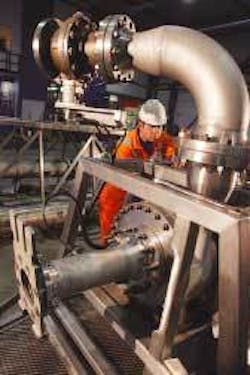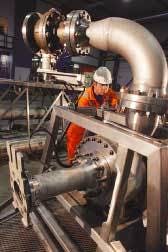Total drills first North Sea well with RMR
Total E&P UK PLC recently used riserless mud recovery (RMR) technology in a dual-gradient, top-hole drilling system to drill a well on the Jura West 3/15-10 prospect.
The recently completed well was drilled with the Sedco 714 semisubmersible rig in 113 m of water and Total was the first to use the new technology in the North Sea.
RMR technology was developed by Ability Subsea AS as a means of recirculating and reusing drilling fluids. Benefits of the technology include cost savings from reduced operating time and reduced environmental impact from avoided discharges to the sea. RMR allows for more controlled handling and disposal of drill cuttings.
Ability Subsea, part of Norway’s AGR Ability Group AS, provides technology and services that extend the boundaries of offshore drilling, especially in geotechnically challenging and environmentally sensitive areas.
RMR technology was recognized in 2005 with a spotlight award at the Offshore Technology Conference (OGJ, May 9, 2005, p. 28). Ability Subsea initially tested the system in the Troll field off Norway and has been using it in the Caspian Sea.
The Azerbaijan International Operating Co. (AIOC), operated by BP PLC, was an early adopter of riserless, dual-gradient technology. In early 2004, BP gave AGR a 2-year, extendable contract to use the system for top-hole drilling in the Azeri field, to cope with shallow gas hazards in the Caspian Sea. Wells were predrilled for Phase 2 of the Azeri, Chirag, and deepwater Gunashli (ACG) field development plan, before the Central Azeri (OGJ, Nov. 1, 2004, p. 9) and East Azeri (OGJ, Aug. 21, 2006, p. 8) platform decks were installed.
In April 2006, Ability Subsea presented the technology in China at a drilling and well service workshop developed by INTSOK-the Norwegian oil and gas partners and Petrad, a non-profit Norwegian government foundation.
Ability had two RMR units operating in first-quarter 2006 and four units during second-quarter in the Middle East and in Russia. The company invested 50 million NOK in RMR equipment during the first 6 months of the year.
Total E&P UK PLC acknowledged a significant time savings over the previous technology used to drill similar 26-in. hole sections and regarded the implementation as successful. The company plans further deployment of the technology later this year.
Use of the RMR technology is spreading. It was recently deployed off Sahkalin Island and in the Barents Sea, where no drilling discharge is permitted. Other applications have been in areas of poor hole stability where an engineered fluid system is required. One of the main advantages of running the system, says the company, is the ability to push planned casing setting depths deeper and hence simplify casing design.
RMR has been deployed in water depths of up to 400 m and Ability Subsea has now commenced development work with two leading oil corporations to make the technology operational in water as deep as 1,500 m. The company plans field trials at these depths for next year.
In July, Shell Australia contracted with Ability Subsea to provide RMR services for its upcoming western Australian exploration.

